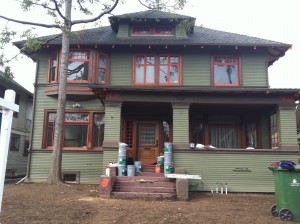I live in an HPOZ (Historic Preservation Overlay Zone), a transitional neighborhood full of architecturally significant homes. If you own one of these historic properties, you must keep the exterior of the building as close to the original as possible. That means you can’t tear it down, you can’t yank off shake shingle and slap on stucco, you can’t remove architectural features like this stained glass window…

…and replace them with something more modern.
You would think that no one with an ounce of aesthetic appreciation would consider futzing with the integrity of these stunning homes, but it happens. Pre HPOZ status, many homes in my neighborhood were desecrated by rooming house slum lords. Glorious rooms featuring mahogany wainscot and gentleman-caller benches and pocket doors were carved up by crappy slap-dash partition walls to make space for more boarders.
Twenty years ago, historic preservation enthusiasts moved into a once-grand neighborhood that had turned into a depressing collection of crackdens and rooming houses. One of my neighbors, who along with his wife has rescued half a dozen properties, describes chasing out a family of drug dealing squatters from a Beaux Arts masterpiece, then restoring it to its original splendor.
When enough homes had been refurbished, historic preservation activists lobbied the city to designate the area an HPOZ in order to keep the architectural integrity of the ‘hood in tact.
During the housing bubble, a home down the block from me had sold for over a million dollars. We had considered renting the house before we bought our craftsman at the opposite end of the street.
The interior of the home was spectacular: refinished oak floors and woodwork, stained and leaded glass features, original fixtures, a pass-through used to pass plates from the butler’s pantry to the formal dining room, tiled fireplaces in the bedrooms.
The front of the house, however, was virtually impossible to make out. The trees that the owners planted in the yard had turned into a jungle that obscured the exterior. Driving by the house, you would never know the jewel that existed behind the overgrown landscaping.
Until a few weeks ago when the owners apparently got tired of carrying such a big mortgage, and listed the house for sale. Motivated sellers, they have yanked out the morrass of trees, painted the house, and sanded and stained the floors. This is what it looks like now:
Just picture some sod, some judiciously placed drought-tolerant plants, a couple of rockers on the front porch and a pitcher of lemonade. A summer afternoon doesn’t get much better than that.
Today I’m thankful for historic preservation — especially in my neighborhood.


That house is incredible. I am sure owning one of these homes takes up a lot of time and money in maintenance, but it’s worth it if you have a passion to do so. Recently some friends of ours bought a Spanish style house in the desert. They promptly changed the interior – including squaring off the rounded corners of archways – to make it a mid-century modern style. To me, that’s insanity.
Sharon — oh no! I don’t approve at all. There are enough mid-century homes out there not to malign a Spanish one.
Interesting issue! After more than a decade living in Hancock Park, I’ve seen the good, bad and the ugly of HPOZs and the lack of them too. The politics of HPOZs can get hopelessly divisive and petty. But, living in an area that didn’t have an HPOZ, I’ve realized that not everyone can be counted on to keep the street’s character intact.